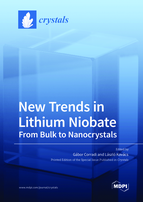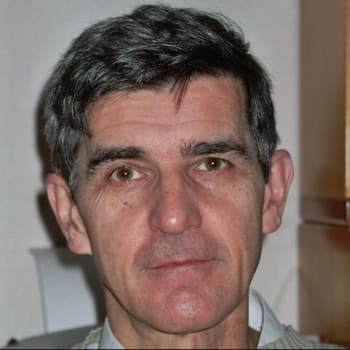New Trends in Lithium Niobate: From Bulk to Nanocrystals
A special issue of Crystals (ISSN 2073-4352). This special issue belongs to the section "Inorganic Crystalline Materials".
Deadline for manuscript submissions: closed (31 March 2021) | Viewed by 72866
Special Issue Editors
Interests: Crystal defects and radiation transients in non-linear oxide crystals and scintillators; paramagnetic resonance
Interests: optical crystals; spectroscopy; point defects; hydroxyl ions; localized vibrations; rare-earth absorption and luminescence
Special Issues, Collections and Topics in MDPI journals
Special Issue Information
Dear Colleagues,
This planned Special Issue of Crystals is already the fourth one focusing on LiNbO3, and this for a good reason. Since its first preparation in 1937, and especially after its Czochralski growth in 1964/65 as a homogeneous artificial crystal with outstanding ferroelectric, non-linear optical, and holographic properties, the widespread use of lithium niobate as a workhorse for testing and realizing new ideas and applications seems to continue in a number of fields. Recent examples are THz phenomena, ultrashort transients, nanocrystals, and delayed electronic response spanning a time range from femtoseconds to minutes, to mention just a few. Miniaturized integrated optics and expected quantum optics applications also require further development and deeper understanding of the technology and functioning of this paradigmatic material in its new forms, including bottom-up assembly and top-down techniques and methods for their control, as well as the investigation and optimization of the modified properties. The sometimes controversial earlier results and new experiments call for new interpretations and their confirmation by theoretical modeling using also recent progress in computational tools.
Contributions of all kinds addressing these and similar topics from specialized or multidisciplinary aspects, including also short reviews, are invited to the special issue of /Crystals/ "New Trends in Lithium Niobate: from Bulk to Nanocrystals" which is dedicated to the memory of Prof. Dr. Ortwin F. Schirmer and is planned to appear by the end of 2020.
Prof. Dr. Gábor Corradi
Prof. Dr. László Kovács
Guest Editors
Manuscript Submission Information
Manuscripts should be submitted online at www.mdpi.com by registering and logging in to this website. Once you are registered, click here to go to the submission form. Manuscripts can be submitted until the deadline. All submissions that pass pre-check are peer-reviewed. Accepted papers will be published continuously in the journal (as soon as accepted) and will be listed together on the special issue website. Research articles, review articles as well as short communications are invited. For planned papers, a title and short abstract (about 100 words) can be sent to the Editorial Office for announcement on this website.
Submitted manuscripts should not have been published previously, nor be under consideration for publication elsewhere (except conference proceedings papers). All manuscripts are thoroughly refereed through a single-blind peer-review process. A guide for authors and other relevant information for submission of manuscripts is available on the Instructions for Authors page. Crystals is an international peer-reviewed open access monthly journal published by MDPI.
Please visit the Instructions for Authors page before submitting a manuscript. The Article Processing Charge (APC) for publication in this open access journal is 2600 CHF (Swiss Francs). Submitted papers should be well formatted and use good English. Authors may use MDPI's English editing service prior to publication or during author revisions.
Keywords
- Crystal growth, defects, modeling
- Transient phenomena
- Nanocrystals, nanopowders
- Integrated optics
- Quantum photonics
- Photovoltaics, ferroelectrics
- THz pulse generation







